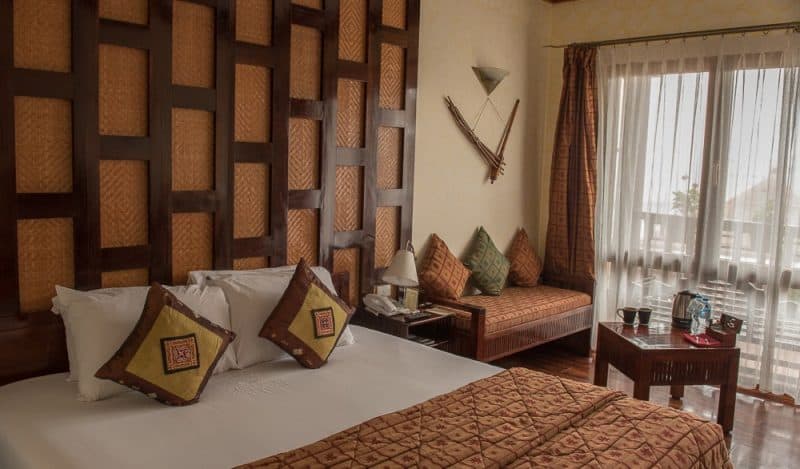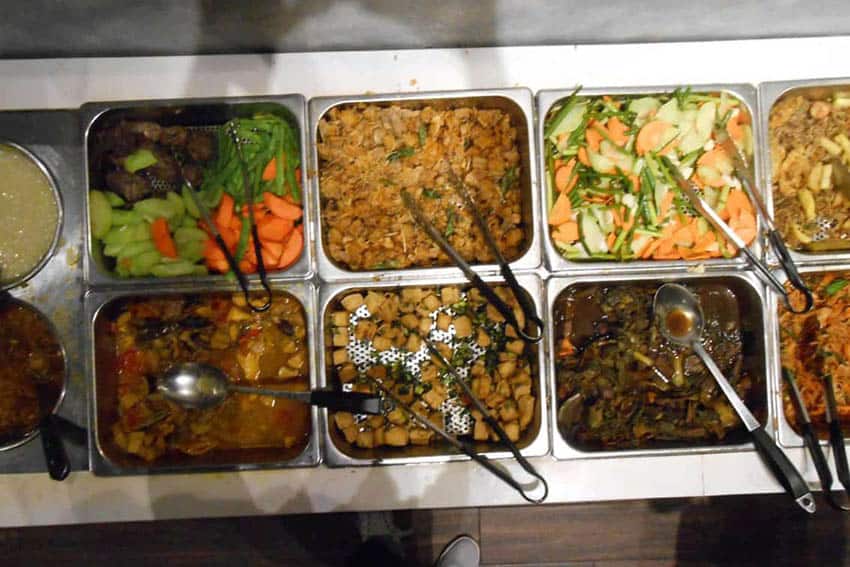
Meeting Villagers and Shopping in Sapa, Vietnam
By Donnie Sexton

Our mini-van had barely come to a halt in the little hamlet of Ta Phin, Vietnam before a surge of local red-hatted women surrounded the door.
They were peering in and pointing, sizing up our group. Only later did we realize they were sorting us out and deciding which of us they would befriend and stick to like super glue while we explored their village on the outskirts of Sapa.
Red Dao Tribe

Ta Phin, our first stop, is home to the Red Dao and the Hmong people. Once off the bus, they escorted us through their village, walking and talking in their broken English punctuated with hand gestures.

The villagers were generous with their time and more than willing to pose for photos in their colorful garb. We were invited into their homes and offered tea.
Some suggested we hold the babies strapped to their backs now that we were fast friends. I was moved by the simplicity of their village, consisting of wooden houses shackled together, small patches of gardens and a few farm animals milling about.
Time to Buy
Our visit to Ta Phin was coming to a close and it was time for the villagers to put the moves on us to purchase their handicrafts. The women began pulling out the goods from large woven baskets they carried on their backs – scarves, small embroidered bags, infant hats, jewelry – it was a treasure trove of local crafts.

Toi, our local guide, let us know we should only buy from the woman who had befriended us, and no others. This was their way of keeping things fair. I was keen on leaving some money for the tribe but wasn’t really interested in what they were selling.
I pulled out the equivalent of $20 and handed it to my new friend.
I tried to gesture that the money was a gift and no need to give me anything in return, but that wasn’t working. Toi said I needed to take one or two items or else she would be offended.

I give these women credit. They had devised a way to share a small slice of their life with outsiders and make a few dollars in the process. They weren’t willing to step on each other’s toes to get the sale.
In this remote location, far off the beaten path of Vietnam’s tourist hubs, their dependence on each other was obvious. We saw firsthand how a tribe holds itself together in harmony and respect for each other.
Trekking Among the Villages
We continued our exploration of the province by getting dropped off at the Linh Ho Village, home of the Black Hmong group, and trekking down a dirt footpath for a few miles to the Ta Vay hamlet.
The Zay and Hmong people occupy Ta Vay. Once again, a small group of women joined us and followed along, as we passed through the terraced rice fields carved into steep hillsides. School had let out, so this trek saw a fair share of kids, laughing, pointing and trying out their few words of English on us.
Our visit to Sapa and the surrounding area was below low-lying clouds, some fog and a great deal of dampness. I wasn’t prepared for the change in temperature compared to sweltering Hanoi, and I was chilly.

Fortunately, Sapa has plentiful shopping for outdoor clothing gear, apparently focused on the trekkers that find their way north.
The prices were unbelievable – deals too good to pass up! The North Face brand was prevalent – maybe these were knockoffs, but all I know, the lined purple North Face jacket I purchased for a whopping $30 was a lifesaver against the cold.
About Giving, Not Need
Today in my overstuffed closet sits a sack with a few small bags, an infant’s ha, and a purple North Face jacket. I wouldn’t call them souvenirs from my trip to Vietnam. The trip itself and all the memories are keepsakes enough.

But they are reminders of how so much of the world lives with so little when I have so much. Travel is the first-hand education and the opportunity to make a difference in the world, however small.
I will never forget what a fellow traveler had said as I surveyed the village handicrafts and mumbled I don’t need this stuff. She whispered it wasn’t about needing anything, it was about giving where there was a need.
The Journey to Sapa

Sapa is the major hub of the Lao Cai province of northwest Vietnam. This mountainous region is home to many ethnic minority peoples who live in small villages throughout the province.
Roughly 220 miles from Hanoi, this province bumps up against the Chinese border. The easiest way to get to Sapa is by overnight train from Hanoi, (opt for a sleeper car), or the more agonizing journey of a long bus ride.
It’s about a nine-hour train ride that leaves Hanoi around 10 pm and arrives early the next morning.

From the train station, it’s another hour drive by bus up to Sapa.
Lodging options in this colorful town vary from hostels to superior hotels, including the upscale Victoria Hotel where we stayed.
While it takes some effort to reach the Lao Cai province, it’s a welcome relief from the overpowering sea of motorbikes, crowds, and pollution of Hanoi.
The area is popular for trekking with a myriad of footpaths winding through the hills and mountains and connecting to the villages of local ethnic tribes.
The region is also home to the highest mountain in Indochina, Fansipan at 10,312 ft. for those needing a bigger challenge to tackle.
- Butte, Montana: Home to the Richest Hill on Earth - April 6, 2024
- Spain’s Extremadura: History and Famous Pigs - December 20, 2023
- Storm Chasing Across Tornado Alley - October 25, 2023



Donnie,
I love this article. It has been a very long time since you brought us to Montana. We had no idea that you have converted to Donnie 2.0. I love your transition and your powerful storytelling. I look forward to future articles and hopefully to seeing you at an event somewhere in the world.
Please look out for a private email from me.
Best regards,
Tonya (& Ian)
Hi Donnie,
I loved this article, how you describe the visit to Sapa and the lovely relationship between the villagers of the tribe, oh if only all people in communities worldwide worked together like that, what a wonderful world it could be!
I have been to Hanoi but only for 24 hours. Air Asia had a promo on, one dollar for a return flight from Bangkok, I couldn’t not go! It is a part of the world I hope to visit again soon, especially the mountains and coast.
I Look forward to reading more of articles, I am trying to develop a freelance travel writing career so I can move to Bulgaria. Reading and learning from published writers is invaluable!
Best wishes,
Louise